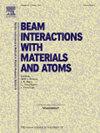Irradiation response of SiOC under simultaneous helium and silicon ion irradiation
IF 1.4
3区 物理与天体物理
Q3 INSTRUMENTS & INSTRUMENTATION
Nuclear Instruments & Methods in Physics Research Section B-beam Interactions With Materials and Atoms
Pub Date : 2025-05-14
DOI:10.1016/j.nimb.2025.165736
引用次数: 0
Abstract
SiOC is an amorphous ceramic with superior irradiation stability, making it attractive for applications in high-temperature and high-radiation environments. However, its glassy state stability under the synergistic effects of helium introduction and heavy damage cascades, as expected in a reactor, has not yet been fully assessed. In this study, e-gun evaporated SiOC was simultaneously irradiated using 150 keV helium at a 45-degree incident angle and 1.5 MeV silicon self-ions at a normal incident angle, at room temperature, 300 °C, and 500 °C, respectively. For all irradiation conditions, high-resolution transmission electron microscopy and electron diffraction analysis across different depths of the film did not reveal any crystallization. However, Si-enriched precipitates appeared, with fewer precipitates observed at the highest irradiation temperature. Surface scanning electron microscopy showed periodic patterning on the surface of both room temperature and 300 °C irradiated samples, but not on the 500 °C irradiated sample. The study demonstrates the overall excellent amorphization resistance of SiOC.
SiOC在氦、硅离子同时辐照下的辐照响应
SiOC是一种非晶陶瓷,具有优异的辐照稳定性,使其在高温和高辐射环境中具有吸引力。然而,它在氦引入和重损伤级联的协同作用下的玻璃态稳定性,如预期的在反应堆中,尚未得到充分的评估。在本研究中,电子枪蒸发的SiOC分别在室温、300°C和500°C下,以150 keV的氦和1.5 MeV的硅自离子以45度入射角同时照射。在所有辐照条件下,高分辨率透射电子显微镜和电子衍射分析均未发现薄膜的任何结晶。但在最高辐照温度下,出现了富si的析出物,且析出物较少。表面扫描电镜显示室温和300℃辐照样品表面均有周期性图案,而500℃辐照样品表面无周期性图案。研究表明SiOC整体上具有优异的抗非晶化性能。
本文章由计算机程序翻译,如有差异,请以英文原文为准。
求助全文
约1分钟内获得全文
求助全文
来源期刊
CiteScore
2.80
自引率
7.70%
发文量
231
审稿时长
1.9 months
期刊介绍:
Section B of Nuclear Instruments and Methods in Physics Research covers all aspects of the interaction of energetic beams with atoms, molecules and aggregate forms of matter. This includes ion beam analysis and ion beam modification of materials as well as basic data of importance for these studies. Topics of general interest include: atomic collisions in solids, particle channelling, all aspects of collision cascades, the modification of materials by energetic beams, ion implantation, irradiation - induced changes in materials, the physics and chemistry of beam interactions and the analysis of materials by all forms of energetic radiation. Modification by ion, laser and electron beams for the study of electronic materials, metals, ceramics, insulators, polymers and other important and new materials systems are included. Related studies, such as the application of ion beam analysis to biological, archaeological and geological samples as well as applications to solve problems in planetary science are also welcome. Energetic beams of interest include atomic and molecular ions, neutrons, positrons and muons, plasmas directed at surfaces, electron and photon beams, including laser treated surfaces and studies of solids by photon radiation from rotating anodes, synchrotrons, etc. In addition, the interaction between various forms of radiation and radiation-induced deposition processes are relevant.

 求助内容:
求助内容: 应助结果提醒方式:
应助结果提醒方式:


